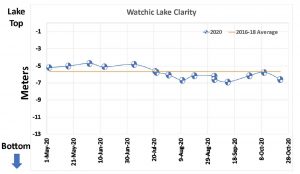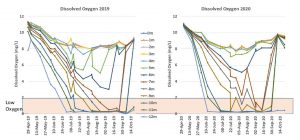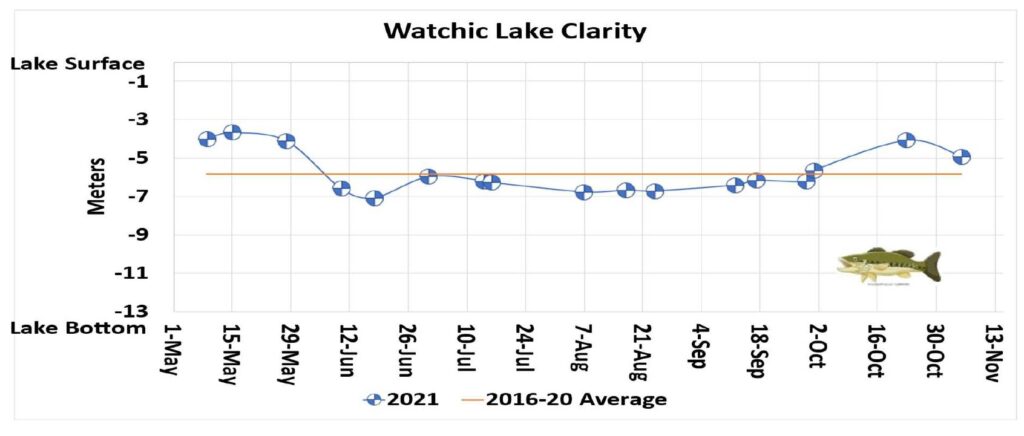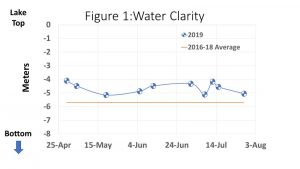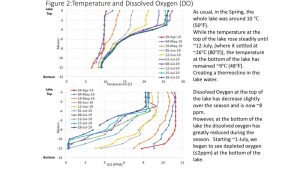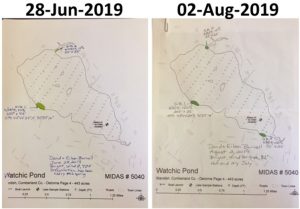2020 Water Quality Report
The 2020 lake season was an interesting one for many reasons, most notably the COVID-19 pandemic. Despite the resulting anxiety and restrictions, the Watchic Lake Water Quality Committee was able to perform the majority of the planned water quality monitoring. Based on the findings contained in this report, the water quality of Watchic Lake remains good and is substantially unchanged from data collected over the previous 4 years (2016-2019). Specifically, water clarity and total phosphorus levels are consistent with previous years and consistent with other Maine lakes like ours. Touch or click on the Water Quality chart to enlarge it.
2020 had a long ice-free/algae growing period for 2020 (283 days). However, the relatively dry Spring and Summer resulted in less algae growth as measured by trophic state indicators (water clarity and core total phosphorus and chlorophyl-A levels) than observed during wetter years. As in recent years, we experience long periods of low dissolved oxygen levels in 2020. Such conditions can restrict fish populations and increase algae growth. Touch or click on the Dissolved Oxygen chart to enlarge it.
However, like all lakes, Watchic Lake is in a delicate balance where both nature and human influences could tip the balance against it. Nutrient laden run-off from storms (especially megastorms) can wash into the watershed and lake causing negative changes in the lake’s water quality. This could lead to significant algae blooms. In addition, while to-date no invasive plant or aquatic species have been identified in Watchic Lake, it only takes a little carelessness to create a big problem.
Touch or click here to read the full 2020 Watchic Lake Water Quality Report.
2019 Water Quality Report
Based on monitoring performed in 2019 by the Water Quality Committee, the water quality of Watchic Lake remains good and is substantially unchanged from data collected over the previous 3 years (2016-2018). As in recent years, a loss of oxygen in the lower depths of the lake was observed in 2019 as the summer progressed (low oxygen restricts viable fish species and may cause bound phosphorus release). In addition, specific observations for this year included a slightly lower average water clarity, a slight increase in the average pH with corresponding decrease in alkalinity and 3 large concentrations of metaphyton (loons need clear water to fish and we all want it for our lake activities). All of these observations will be monitored closely in 2020.
While water quality is good today, Watchic Lake remains at risk over the long term. Nutrient laden run-off from storms (especially mega-storms) can enter the watershed and lake causing negative changes in the lake’s water quality. This could lead to significant algae blooms. In addition, while to-date no invasive plant or aquatic species have been identified in Watchic Lake, it only takes a little carelessness to create a big problem. Homeowners must be diligent on both counts: stop storm run-off entering the lake and always remove plant and other organic material from boats and fishing gear.
The Watchic Lake Watershed Protection Plan sponsored by the Watchic Lake Association (WLA) is being reviewed by the Environmental Protection Agency and will be finalized soon. This report will provide more specifics on how property owners and the Town of Standish can help protect our lake.
Please click or touch for the Full 2019 Water Quality Report.
Thank you to our water quality volunteers Cathy Watson, Eileen and David Burnell, and Wendi Rodrigueza!
2019 Summer Water Quality Update
The water quality committee has been out on the lake about 10 times this season checking the water quality. You may have noticed that the water clarity is lower than usual. Water clarity can change for several reasons. This year one big influencer of lower clarity is our wet spring and the resulting increase in nutrients (especially phosphorus) that was washed into the lake. We measure clarity using a Secchi disk. Figure 1 belows shows the readings this year and the historical average for 2016-2018.
Temperature and Dissolved Oxygen: As expected, the temperature in the lake has stratified, where the top is warm (this area is where we see most of the activity (e.g. algae growth) while the bottom remains cool. The DO pattern over time is also what we’ve seen in recent years. The lack of oxygen at the bottom of the lake will restrict fish species that like colder water, but may also cause phosphorus stored at the bottom of the lake to be released into the lake. This phosphorus can fuel further algae growth. We will start measuring and tracking the phosphorus levels at the bottom of the lake this month to monitor for changes. Figure 2 shows the water temperature and dissolved oxygen (DO) at 1-meter intervals from the top of the lake down.
The Water Quality team has documented a series of metaphyton algal blooms. Metaphyton is cotton candy-like algae that usually floats near the top of the shallow water but can get stuck in lake vegetation and accumulate. It is not harmful, but very unpleasant to swim in. This spring large accumulations of metaphyton were reported just north of the Kiwanis Beach, in the mouth of Page Brook, and near the mouth of Paine Brook. We will continue to monitor the areas and the rest of the lake for metaphyton.
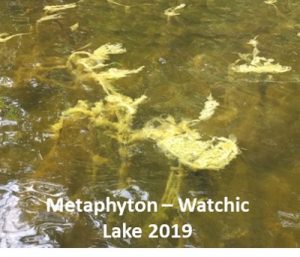
These algae, like most others, are fueled by extra nutrients entering the lake, most likely from storm run-off or septic tank issues. Other things driving recent observations include:
- Warmer temperatures for longer periods of time:
- Early Ice-Out/late Ice-In dates and the resulting longer growing season for algae in the lake.
- Thinner ice allowing more light into the lakes so plants and algae may not die during the winter.
- More severe weather events (rain and droughts) resulting in more nutrients from storm run-off entering the lakes and streams.
The team has also attended the annual Lake Stewards of Maine Lake Monitoring Conference to learn more about to best monitor Watchic water quality. From the conference, they learned that what we are observing on our lake is typical for lakes in Maine. The lakes are in a delicate balance with their environment and climate change is definitely having and will continue to have a major impact on our lake.
Click or touch here to read the full mid-summer water quality update.
2018 Water Quality Report
We have just completed our 2018 water quality report for Watchic Lake. The data used in this report comes from readings done by FB Environmental and WLA volunteers. All data has been certified and has been submitted to Maine VLMP. This report includes the same rich set of testing we did in 2016 and 2017. The report also includes a summary of water quality metrics over the past three years.
In summary, the report states that while water quality is good today, Watchic Lake remains at long term risk due the increasing human activities around the lake. The main concern at Watchic Lake is the low dissolved oxygen in the bottom waters. Low oxygen conditions can release nutrients (phosphorus) attached to sediments on the lake bottom. Adding phosphorus to the lake can stimulate excessive algal growth. High phosphorus in both of the inlet streams suggests that there is also phosphorus entering the lake from the surrounding watershed. Both low oxygen and high productivity can be dangerous for aquatic organisms and fish. Click or touch here to read the 2018 Watchic Lake Water Quality Report.
The message is clear – as property owners and interested stakeholders, we must work to address increasing runoff into the lake to improve oxygen levels, avoid algal blooms and excessive plant growth, and retain a healthy habitat for fish, loons, and other wildlife.
The Lake
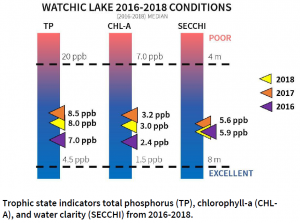 Trophic state indicators (total phosphorus, chlorophyll-a, and water clarity) showed that water quality in Watchic Lake remains overall very good.
Trophic state indicators (total phosphorus, chlorophyll-a, and water clarity) showed that water quality in Watchic Lake remains overall very good.
However, low oxygen (< 5 ppm) in the summer months continues to make the bottom waters of the lake unsuitable habitat for aquatic life that have historically been an important natural and recreational asset to the lake (e.g., smelt). This oxygen depletion is caused by the decomposition of organic matter (i.e., dead algae and plant matter) that has settled on the lake bottom. While it is difficult to remedy what has already been done, the best way to combat future worsening of oxygen depletion in Watchic Lake is to limit the amount of nutrient input to the lake and streams.
pH in the lake is within the acceptable range for aquatic life, but low alkalinity is classified as highly sensitive, meaning that the lake is not well-buffered against environmental factors that may cause significant changes in pH.
The Tributaries – Page (northern end) and Paine (southern end) Brooks
Both streams exhibited low fecal indicator bacteria (E. coli) counts.
Nutrients (nitrogen and/or phosphorus) were elevated in both streams, indicating human pollution from septic systems, fertilizers, surface runoff, etc. Both streams experienced low oxygen and low pH, which can negatively impact the growth and reproductive health of aquatic life. Low oxygen (particularly in Page Brook) and low pH can be the result of natural or human sources, but are likely from human sources considering the elevated nutrient levels measured in the streams.
We thank all our members, sponsors, and especially the Town of Standish, for supporting this study.
Use the Contact Us page should you have questions.
2017 Water Quality Report Available
We have completed our 2017 water quality report for Watchic Lake. The data used in this report comes from readings done by FB Environmental and WLA volunteers. All data has been certified and has been submitted to Maine VLMP. This report includes the same rich set of testing we did in 2016. The report includes a very useful glossary of terms and some great educational material.
In summary, the report states that while water quality is good today, Watchic Lake remains at long term risk due the increasing human activities around the lake which can increase the amount and transport of harmful pollutants and foreign materials into the lake and its streams. Catastrophic events such as mega-storms put roads, drainages, and septic systems at risk of introducing toxic runoff.
The message is clear – as property owners and interested stakeholders, we must work to address increasing runoff into the lake to improve oxygen levels, avoid algal blooms and excessive plant growth, and retain a healthy habitat for fish, loons, and other wildlife.
The Lake
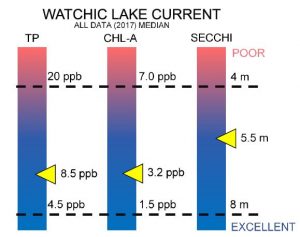 Trophic state indicators (total phosphorus, chlorophyll-a, and water clarity) showed that water quality in Watchic Lake is overall very good.
Trophic state indicators (total phosphorus, chlorophyll-a, and water clarity) showed that water quality in Watchic Lake is overall very good.
However, low oxygen (< 5 ppm) in the summer months is making 14-32% of lake volume a less suitable habitat for aquatic life that have historically been an important asset to the lake (e.g., smelt). This oxygen depletion is caused by the decomposition of organic matter (i.e., dead algae and plant matter) that has settled on the lake bottom. Low oxygen can cause a chemical reaction that releases phosphorus back into the water column to fuel more algae growth (thus generating a positive feedback to eutrophication). The best way to combat future worsening of oxygen depletion in Watchic Lake is to limit the amount of runoff into the lake and streams.
The Tributaries – Page (northern end) and Paine (southern end) Brooks
Nutrients (nitrogen and/or phosphorus) were elevated in both streams, indicating human pollution from septic systems, fertilizers, surface runoff, etc. Paine Brook showed higher nitrogen, while Page Brook showed higher phosphorus. Consistent with these elevated levels, both streams experienced low oxygen and low pH. Although Paine Brook had higher average fecal indicator bacteria (E. coli) counts than Page Brook, both streams exhibited low readings overall. An analysis of land use may help determine differences in nutrient sources draining into each stream.
As property owners and interested stakeholders, we must continue to work to address these risks, in order to avoid algal blooms, low oxygen levels, excessive plant growth, and uncontrolled shoreline erosion.
We thank all our members, sponsors, and especially the Town of Standish, for supporting this study.
Please read the full report here and use the Contact Us page should you have questions.
2016 Water Quality Report Update
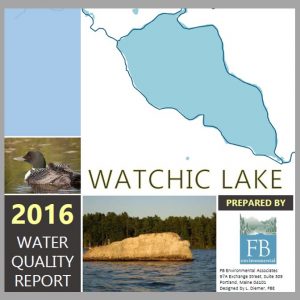 We have completed our 2016 water quality report for Watchic Lake. The data used in this report comes from readings done by FB Environmental and WLA volunteers. All data has been certified and has been submitted to Maine VLMP. This report includes a much richer set of testing than we have done in the past. In addition, the report includes some great educational material on water quality management.
We have completed our 2016 water quality report for Watchic Lake. The data used in this report comes from readings done by FB Environmental and WLA volunteers. All data has been certified and has been submitted to Maine VLMP. This report includes a much richer set of testing than we have done in the past. In addition, the report includes some great educational material on water quality management.
In summary, the report states that the water quality for the main body of Watchic Lake is overall very good, but we need to watch out for: Low Oxygen, Internal Phosphorous Loading, and Low PH. Water quality is fair at the streams entering the lake at Paine and Page brooks. Stream quality is felt only to be fair due to Low Oxygen, Low PH, and Elevated Nutrients. This is the first year we have measured the streams, and will continue to do so in 2017.
While water quality is good today, Watchic Lake remains at risk over the long term. Ever increasing human activities within the watershed can increase the amount and transport of harmful pollutants and dangerous foreign materials into the lake and its streams. Catastrophic events such as mega-storms put roads, drainage systems, and septic systems at risk of introducing toxic runoff. As property owners and interested stakeholders, we must continue to work to address these risks, in order to avoid algal blooms, excessive plant growth, and uncontrolled shoreline erosion.
We thank all our members, sponsors, and especially the Town of Standish, for supporting this study.
Please read the full report here and use the Contact Us page should you have questions.
Fall 2016 Water Quality Monitoring Update
2016 has been a unique year for Watchic Lake. It started in the spring with the earliest ice-out on record. Surface Metaphyton was noted in April that was different in characteristics than the sub-surface Metaphyton that is common in late summer months. Metaphyton is a non-invasive but unpleasant algae that grow predominantly in shallow and warmer water. Spring was followed by an uncommonly hot and dry summer with numerous unusual biological phenomena. Dry weather has historically meant that Watchic has its best water clarity. This could be attributed to less runoff and nutrients reaching the water. It will be interesting to see how this year compares.
Monitoring is now being done by two parties. In 2016, in efforts to gather additional water quality data, the Watchic Lake Association hired FB Environmental to monitor various parameters at the deep hole (the deepest part of the lake) including dissolved oxygen, temperature, Secchi disk transparency, total phosphorus, total nitrogen, total organic carbon, chlorophyll-a, alkalinity, pH, and color. FBE also sampled Page and Paine Brooks for total phosphorus, total nitrogen, pH, E. coli, dissolved oxygen, and temperature. Three dissolved oxygen Onset HOBO ™ loggers attached to the buoy at the deep hole will show when spring and fall turnover occur and track stratification of the lake. The loggers will continue to read data until they are removed on November 1. Due to the fact that we are using additional tests from a new organization (FBE), our formal 2016 water quality report from FBE will not be completed until late in the year when we receive our 2016 report.
David and Eileen Burnell have returned as certified lake monitors with the Volunteer Lake Monitoring Program. They are taking Secchi disk readings at the deep hole twice a month. This year the testing began in May and will conclude in early October due low lake water levels. The VLMP report will be available in the spring of 2017. Their data to date for 2016 can be seen at mainevlmp.org Near Real-Time Lake Data. Earlier data and other information can be found as Watchic Pond on the Maine VLMP site. Some more recent content has not yet been entered by the VLMP.
Eileen D. Burnell, Watchic Lake Association, Water Quality Monitor
Spring-Summer 2015
Based on observations made throughout the spring season and into the summer of 2015, overall lake water quality remained consistent. The average depth of clarity has been between 3.4 and 4.6-meters, based on Secchi disk readings. The range of readings collected this year has been typical compared to previous years. The lake continues to support a diverse and apparently healthy eco-system that included a variety of birds, fish and other wildlife. The summer weather has been relatively dry and kept lake water levels consistent, which has minimized shoreline erosion and the potential for impacts from run-off. The full report can be found here WLA Water Quality Report 2015.
As always, I appreciate any help that others wish to give in ensuring the preservation of Watchic Lake and I am more than happy to help others find ways to do their part in this as well. Please feel free to contact us via our Contact Us form or call Eben at (207) 838-5557.
Fall-Winter 2015
The overall water quality for a lake the size and depth of Watchic Lake continues to be quite good, supporting a diverse and healthy eco-system that includes a variety of birds, fish and other wildlife. For the report click here Watchic Lake Water Quality Report Fall-Winter 2015.
The summer weather was relatively dry and kept lake water levels consistent, which minimized shoreline erosion and the potential for impacts from run-off. The summer weather created conditions within the lake that led to an increase in observed algae in the lake. Though unsightly, the types of algae observed were non-invasive, native species. Algae provided food and natural cover for various species of aquatic wildlife. The type and volume of algae within the lake will continue to be monitored.
The 2014-2015 winter brought record snowfall totals to much of southern New England; however, snowfall amounts in the Watchic Lake watershed were consistent with what may be considered a “normal” winter. As winter has begun to slowly give way to spring, attention will be turned to snowmelt and potential for flooding. It is important for land owners with significant slopes that lead into the lake to monitor the condition of their property and attempt to identify areas where improvements can be made to reduce run-off as well as protect their property.
Water quality sampling is anticipated to be performed in June 2015. As with prior sampling events, lake water samples collected from various locations within the lake will be laboratory analyzed for the presence of coliform bacteria, as well as nitrogen and phosphorus, which are common constituents of run-off into the lake. Secchi disk readings will continue to be collected to assess the clarity of lake water.
As always, I appreciate any help that others wish to give in ensuring the preservation of Watchic Lake and I am more than happy to help others find ways to do their part in this as well. Please feel free to contact us via our Contact Us form or call Eben at (207) 838-5557.
Spring-Summer 2014
The overall water quality for lake the size and depth of Watchic Lake is quite good. For the report click here Watchic Lake Water Quality Report Spring-Summer 2014.
Based on the data collected for the first half of the monitoring season (June to July 2014) the average depth of clarity for Watchic Lake is 3.6 – 4.4 meters (12-15 feet) based on Secchi disk readings. The range of readings to date was typical of prior year’s readings, though slightly lower initially due to a persistent amount of pine pollen suspended within the water column. The pine pollen issue ran its course by the middle/end of June.
In June, lake water samples were collected from various locations within the lake and analyzed by Katahdin Laboratories for the presence of coliform bacteria. The results (from 3.1 coliform forming unit (cfu)/100mL to 29.2 cfu/100mL) were well below the maximum allowable density of 235 cfu/100mL. Additional samples, from around the lake, were collected and analyzed for nitrogen and phosphorus, which are common constituents of run-off into the lake. Total nitrogen and phosphorus results were very low, and similar to last year’s results. Another round of these analyses will be conducted later in the summer.
As has been noted in prior reports, the lake’s water quality is in a favorable condition and is supporting a diverse eco-system. The quality of the lake’s water has been evident by the variety and number of aquatic, amphibian, and avian species that call Watchic Lake home. Further assessment of lake water quality will be performed in the late summer of 2014. As always, we appreciate any help that others wish to give in ensuring the preservation of Watchic Lake and we are am more than happy to help others find ways to do their part in this as well. Please feel free to contact us via our Contact Us form, or call Eben Joslyn at (207) 838-5557.
Winter 2013-2014
This winter the lake has been consistently covered with an ice sheet that has provided a good surface for many winter activities. Reports by those who have been fishing the lake this winter have indicated that the catch has been good to date. Pending a slow snow melt and ease into spring, conditions are such that lake water quality should remain consistent.
In August 2013, the Watchic Lake Association was notified by local authorities that a complaint regarding septic discharge to the lake had been lodged by a resident. WLA members performed response activities that included discussions with local and state regulatory agencies, visual investigation of the alleged release, and lake water sampling activities. Lake water samples were collected in the vicinity of the alleged release, as well as control locations for comparison, and analyzed by Katahdin Laboratories for the presence of coliform bacteria. All sample results were similar and did not indicate that a release to the lake had occurred. This incident provided an opportunity for WLA members to work with regulatory agencies, lake residents, and outside vendors to coordinate response activities.
As has been noted in prior reports, the lake’s water quality is in a favorable condition and is supporting a diverse eco-system consisting of many types of plants and wildlife. Further assessment of lake water quality will be performed in the spring of 2014.
As always, we appreciate any help that others wish to give in ensuring the preservation of Watchic Lake. Please feel free to contact us via our Contact Us form, or call Eben at (207) 838-5557.
Spring – Summer 2013
Based on the data collected for the first half of the monitoring season (June to July 2013) the average depth of clarity for Watchic Lake is 3.8 – 4.5 meters. This data is based on Secchi disk readings collected by Eben Joslyn (Volunteer Lake Monitor) in accordance with the guidelines set forth by the Maine Volunteer Lake Monitoring Program. The range of readings this year is typical and expected given the spring conditions, followed by significant rain in June.
In June, lake water samples were collected from various locations within the lake and analyzed by Katahdin Laboratories for the presence of coliform bacteria. The results (from <1 cfu/100mL to 6.3 cfu/100mL) were well below the maximum allowable density of 235 cfu/100mL. Additional samples, from around the lake, were collected and analyzed for nitrogen and phosphorus, which are common constituents of run-off into the lake. The results of these analyses were non-detect for nitrate and nitrite, both indicators of failing septic or leach field systems. Total nitrogen and phosphorus results were very low, and similar to last year’s results. Another round of these analyses will be conducted later in the summer.
As has been noted in prior year’s reports, the lake’s water quality is in a favorable condition and is supporting a diverse eco-system consisting of many types of plants and wildlife. As always, we appreciate any help that others wish to give in ensuring the preservation of Watchic Lake. Please feel free to contact us via our Contact Us form, or call Eben at (207) 838-5557.

